15-5 Meteorites are classified as stones, stony irons, or irons, depending on their composition
 Asteroids can only be studied at close range using spacecraft. But from time to time pieces of asteroids fall to Earth where they can be examined by scientists. These asteroid fragments are called meteorites.
Asteroids can only be studied at close range using spacecraft. But from time to time pieces of asteroids fall to Earth where they can be examined by scientists. These asteroid fragments are called meteorites.
Meteoroids, Meteors, and Meteorites
A meteoroid, like an asteroid, is a chunk of rock or metal in space. There is no official dividing line between meteoroids and asteroids, but as of 2010 some astronomers define meteoroids as objects measuring less than 1 m across.
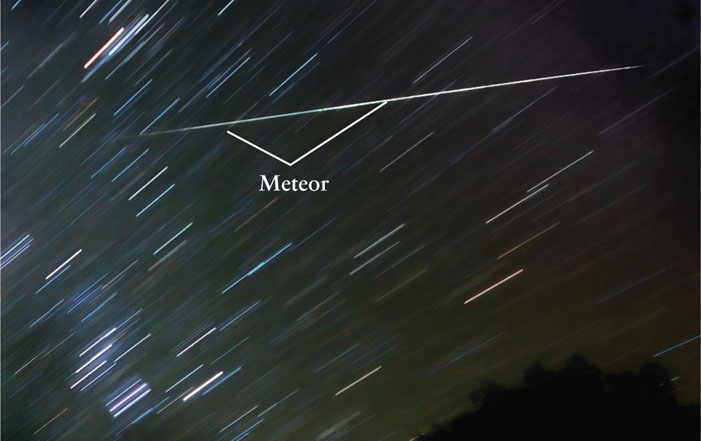
A Meteor A meteor is produced when a meteoroid—a piece of interplanetary rock or dust—strikes Earth’s atmosphere at high speed (typically 5 to 30 km/s). The light comes from heat as the air in front of the meteor is highly compressed. This heat also vaporizes rock and most meteoroids burn up completely at altitudes of 100 km (60 mi) or so. This long exposure (notice the star trails) shows an exceptionally bright meteor called a fireball.
A meteor is the brief flash of light (sometimes called a shooting star) that is visible at night when a meteoroid enters Earth’s atmosphere (Figure 15-19). The shooting star begins with an incoming rock about 50 km high in Earth’s atmosphere. As the fast-moving meteoroid rams into the air in front of it, the compressed air heats up to about 3000 K and produces the bright trail of light we see. The width of the bright streak might only be a meter or so wide, and cools in less than a second. However, due to the rock’s high speed, the bright trail can be several kilometers long.
While an impressive sight, the size of a typical meteoroid entering Earth’s atmosphere is between a sand grain and a pebble. For incoming rocks less than 10 m wide, the same heat that produces its bright trail vaporizes most of the object. Therefore, the typical meteoroid is completely burned up in the atmosphere. On the other hand, small particles of cosmic dust (see Figure 8-9) slow down quickly, produce little heat, and continuously drift down to Earth’s surface without being noticed.
Studying meteorites reveals the properties of the asteroids from which they came
If a piece of rock or metal survives its fiery descent through the atmosphere and reaches the ground, it is called a meteorite. As incredible as it may seem, an estimated total of 80 tons of extraterrestrial matter falls on Earth each day. However, most of this matter is cosmic dust rather than meteorites. It is fortunate that large meteorite falls are rather rare events—direct hits can cause damage (Figure 15-20). Because they are so rare, meteorites are prized by scientists and collectors alike. Almost all meteorites are asteroid fragments and thus provide information about the chemical composition of asteroids. A very few meteorites have been identified as pieces of the Moon, Mars, or the asteroid Vesta, that were blasted off the surfaces of those worlds by violent impacts.
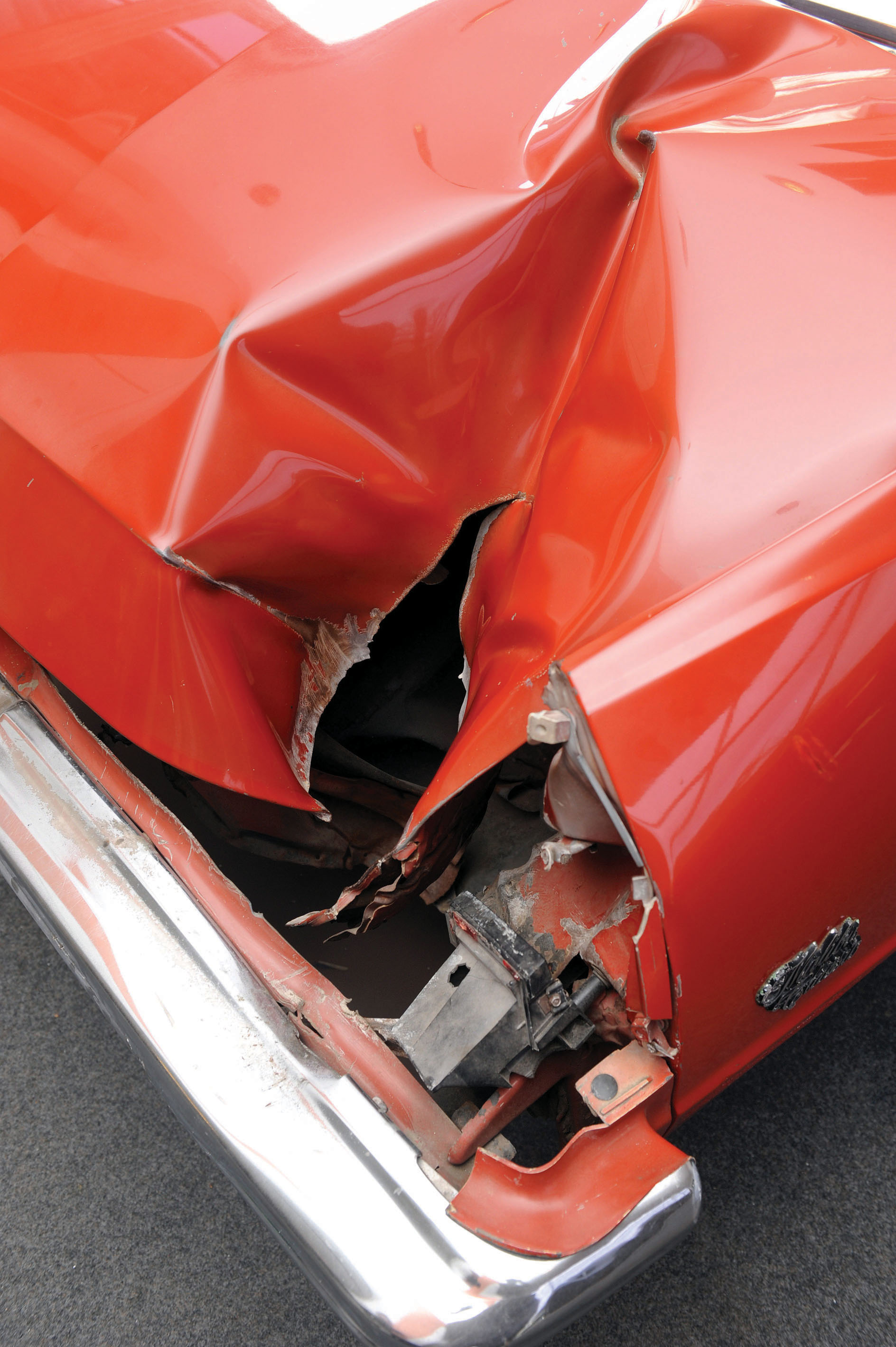
A Meteorite “Fender-Bender” On the evening of October 9, 1992, Michelle Knapp of Peekskill, New York, heard a noise from outside that sounded like a car crash. She discovered that the trunk of her car had been smashed by a 12-kilogram (27-pound) meteorite, which was lying beside the car and was still warm to the touch. Meteorite damage is not covered by automobile insurance, but Ms. Knapp was offered several tens of thousands of dollars for the meteorite (and the car).
People have been finding specimens of meteorites for thousands of years, and descriptions of them appear in ancient Chinese, Greek, and Roman literature. Many civilizations have regarded meteorites as objects of veneration. The sacred Black Stone, enshrined at the Ka’aba in the Great Mosque at Mecca, may be a relic of a meteorite impact. More recently, selling meteorites has become profitable enough that when scientists show up to investigate an impact, oftentimes the fragments have already been taken.
The extraterrestrial origin of meteorites was hotly debated until as late as the eighteenth century. Upon hearing a lecture by two Yale professors, President Thomas Jefferson is said to have remarked, “I could more easily believe that two Yankee professors could lie than that stones could fall from Heaven.” Although several falling meteorites had been widely witnessed and specimens from them had been collected, many scientists were reluctant to accept the idea that rocks could fall to Earth from outer space. Conclusive evidence for the extraterrestrial origin of meteorites came on April 26, 1803, when fragments pelted the French town of L’Aigle. This event was analyzed by the noted physicist Jean-Baptiste Biot, and his conclusions helped to finally convince scientists that meteorites were indeed extraterrestrial.
Types of Meteorites
Meteorites are classified into three broad categories: stones, stony irons, and irons. As their name suggests, stony meteorites, or stones, look like ordinary rocks at first glance, but they are sometimes covered with a fusion crust (Figure 15-21a). This crust is produced by the melting of the meteorite’s outer layers during its fiery descent through the atmosphere. When a stony meteorite is cut in two and polished, tiny flecks of iron can sometimes be found in the rock (Figure 15-21b). Meteorites collected from the 2013 Chebarkul impact event are of this type and contain about 10% iron.
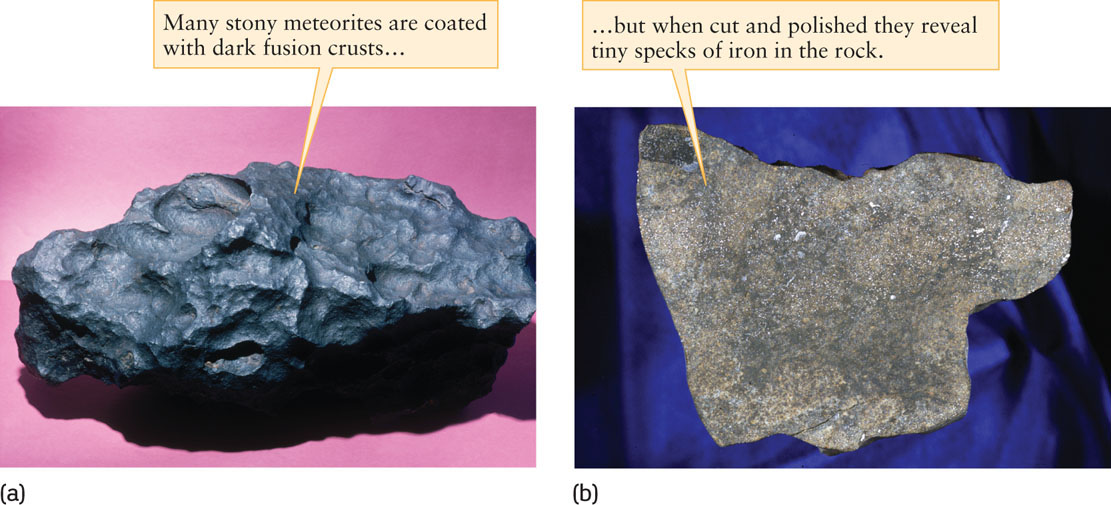
Stony Meteorites Of all meteorites that fall on Earth, 95% are stones. (a) Many freshly discovered specimens, like the one shown here, are coated with dark fusion crusts. This particular stone fell in Texas. (b) Most stony meteorites contain small grains of nickel-rich iron distributed throughout the rock. Chondrules are also evident in this specimen from Australia.
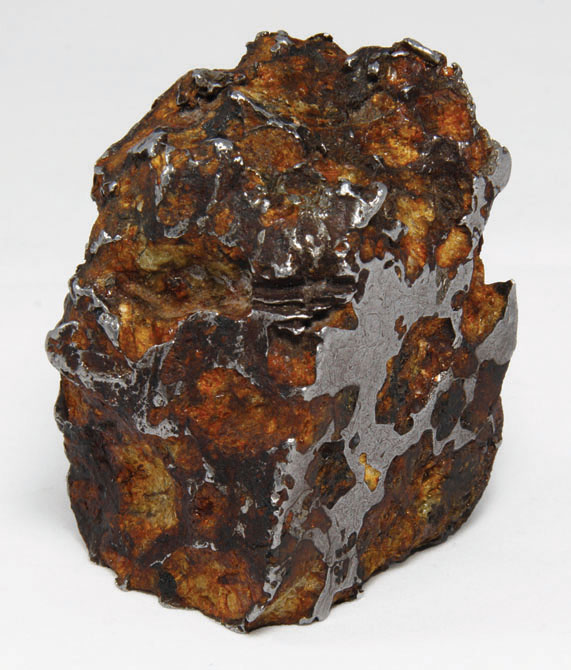
A Stony Iron Meteorite Stony irons account for about 1% of all the meteorites that fall to Earth. This particular specimen, a variety of stony iron called a pallasite, fell in Chile.
Although stony meteorites account for about 95% of all the meteoritic material that falls to Earth, they are the most difficult meteorite specimens to find. If they lie undiscovered and become exposed to the weather for a few years, they look almost indistinguishable from common terrestrial rocks. (The asteroid that caused the Tunguska explosion, described in Section 15-4, was probably of stony composition, which would account for the lack of obvious meteoritic debris on the ground.) Meteorites with high iron content can be found much more easily, because they can be located with a metal detector. Consequently, iron and stony iron meteorites dominate most museum collections.
Stony iron meteorites consist of roughly equal amounts of rock and iron. Figure 15-22, for example, shows the mineral olivine suspended in a matrix of iron. Only about 1% of the meteorites that fall to Earth are stony irons.
Iron meteorites (Figure 15-23), or irons, account for about 4% of the material that falls on Earth. Iron meteorites usually contain no stone, but many contain from 10% to 20% nickel. Before humans began extracting iron from ores around 2000 b.c.e., the only source of the metal was from iron meteorites. Because these are so rare, iron was regarded as a precious metal like gold or silver.
In 1808, Count Alois von Widmanstätten, director of the Imperial Porcelain Works in Vienna, discovered a conclusive test for the most common type of iron meteorite. About 75% of all iron meteorites have a unique crystalline structure. These Widmanstätten patterns (pronounced VIT-mahn-shtetten) become visible when the meteorite is cut, polished, and briefly dipped into a dilute solution of acid (Figure 15-23b). Nickel-iron crystals of this type can form only if the molten metal cools slowly over many millions of years. Therefore, Widmanstätten patterns are never found in counterfeit meteorites, or “meteorwrongs.”
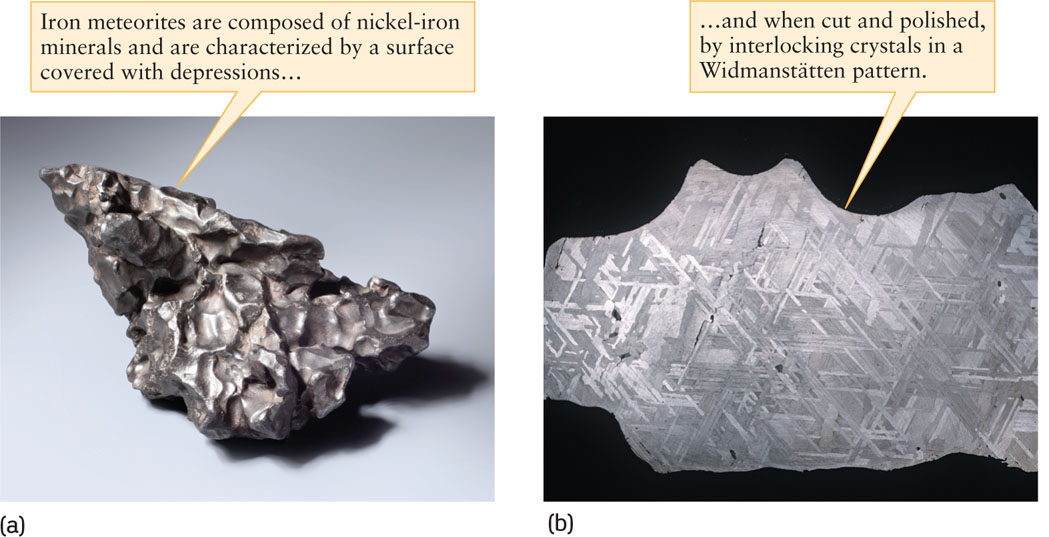
Iron Meteorites (a) The surface of a typical iron is covered with small depressions caused by ablation (removal by melting) during its high-speed descent through the atmosphere. Note the one-cent coin for scale. (b) When cut, polished, and etched with a weak acid solution, most iron meteorites exhibit interlocking crystals in designs called Widmanstätten patterns.
Meteorites and the Early History of Asteroids
Widmanstätten patterns suggest that some asteroids were originally at least partly molten inside and remained partly molten long after they were formed. As soon as an asteroid accreted from planetesimals some 4.56 billion years ago, rapid decay of short-lived radioactive isotopes could have heated the asteroid’s interior to temperatures above the melting point of rock. If the asteroid was large enough—at least 200 to 400 km in diameter—to insulate the interior and prevent it from cooling, the interior would have remained molten over the next few million years and chemical differentiation would have occurred (see Box 7-1 and Section 8-5). Iron and nickel would have sunk toward the asteroid’s center, forcing less dense rock upward toward the asteroid’s surface.
Like a terrestrial planet, such a differentiated asteroid would have a distinct core and crust. After a differentiated asteroid cooled and its core solidified, collisions with other asteroids would have fragmented the parent body into meteoroids. Iron meteorites are therefore specimens from a differentiated asteroid’s core, while stony irons come from regions between a differentiated asteroid’s core and its crust.
Unlike irons and stony irons, stony meteorites may or may not come from differentiated asteroids. Smaller asteroids would not have retained their internal heat long enough for chemical differentiation to occur. Some stony meteorites are fragments of such undifferentiated asteroids (also called primitive asteroids), while others are relics of the crust of differentiated asteroids.
CALCULATION CHECK 15-2
If a meteor passes through Earth’s atmosphere at about 5 km/s, how long is the tail if the atmosphere heated by the meteor only remains hot enough to be visible for about 1 second?
5 km. (5 km/s) × (1 s) = 5 km.
CONCEPT CHECK 15-7
Why does a Widmanstätten pattern ensure that a sample is truly a meteorite?
If a nickel-iron sample cools too quickly, it will not contain a Widmanstätten pattern, which takes millions of years to form. This is not a feature that can be artificially produced on Earth.